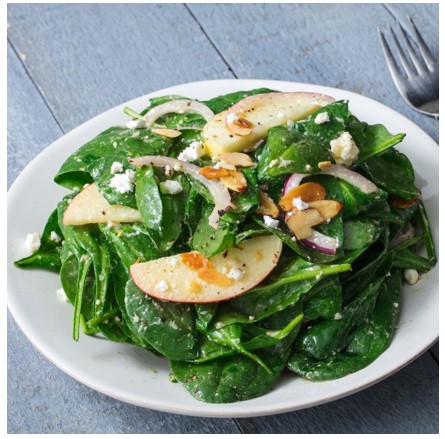Warfarin sodium (Coumadin) is ordered for a client.
The client asks the nurse about dietary restrictions while taking this medication. Which of the following foods should be limited?
Wheat bread and butter.
Mangoes and tomatoes.
Spinach and salads.
Aged cheeses and wine.
The Correct Answer is C
This is because spinach and salads contain a lot of vitamin K, which can make warfarin less effective at preventing blood clots.

Vitamin K helps the blood to clot, so eating foods high in vitamin K can counteract the effect of warfarin.
Choice A is wrong because wheat bread and butter do not contain a lot of vitamin K and do not affect warfarin.
Choice B is wrong because mangoes and tomatoes do not contain a lot of vitamin K and do not affect warfarin.
Choice D is wrong because aged cheeses and wine do not contain a lot of vitamin K and do not affect warfarin.
It is important to keep a stable diet while taking warfarin and avoid sudden changes in the amount of vitamin K intake. Foods that are high in vitamin K include green leafy vegetables, chickpeas, liver, egg yolks, avocado, and olive oil.
These foods should be limited but not eliminated from the diet. Do not drink cranberry or grapefruit juice while taking warfarin as they can increase the risk of bleeding.
Nursing Test Bank
Naxlex Comprehensive Predictor Exams
Related Questions
Correct Answer is A
Explanation
A 37-year-old who has insulin-dependent diabetes mellitus has the greatest need for special mouth care. This is because diabetes can affect the blood vessels and nerves in the mouth, leading to dry mouth, gum disease, infections, and delayed healing. Special mouth care for this client would include regular brushing and flossing, using a soft toothbrush or foam brush, rinsing with water or saline, checking for signs of inflammation or infection, and avoiding sugary or acidic foods and drinks.
Choice B is wrong because a 58-year-old who wears dentures does not have a greater need for special mouth care than a diabetic client.
Dentures can be removed and cleaned with a soft toothbrush and denture cleaner, and soaked overnight in a denture solution. The gums and mouth should also be cleaned daily with a soft toothbrush or gauze.
Choice C is wrong because a 26-year-old who is on bed rest does not have a greater need for special mouth care than a diabetic client. Bed rest can cause dry mouth and plaque accumulation, but these can be prevented by regular brushing and rinsing, drinking water frequently, and using sugar-free gum or lozenges.
Choice D is wrong because a 45-year-old who is NPO (nothing by mouth) does not have a greater need for special mouth care than a diabetic client. NPO can cause dry mouth and bad breath, but these can be alleviated by regular rinsing with water or saline, applying water-based lip balm or moisturizer, and using artificial saliva products if needed.
Correct Answer is C
Explanation
This is because restraints should only be used as a last resort when other alternatives have failed to ensure the patient’s safety and when there is a valid order from the primary healthcare provider.
Assessing the need for restraints placement involves evaluating the patient’s condition, behavior, risk factors, and potential benefits and harms of using restraints.
Choice A is wrong because visual inspection of skin for placement is done after applying restraints, not before.
This is to check for any signs of injury, irritation, or circulation impairment caused by the restraints.
Choice B is wrong because positioning for proper body alignment is done during and after applying restraints, not before.
This is to prevent complications such as pressure ulcers, contractures, or nerve damage due to improper positioning.
Choice D is wrong because reviewing facility policy before usage is not a nursing intervention, but a legal and ethical requirement.
Nurses should be familiar with the facility policy and guidelines regarding the use of restraints and follow them accordingly.
However, this does not replace the need for individualized assessment and evaluation of each patient’s situation.
Whether you are a student looking to ace your exams or a practicing nurse seeking to enhance your expertise , our nursing education contents will empower you with the confidence and competence to make a difference in the lives of patients and become a respected leader in the healthcare field.
Visit Naxlex, invest in your future and unlock endless possibilities with our unparalleled nursing education contents today
Report Wrong Answer on the Current Question
Do you disagree with the answer? If yes, what is your expected answer? Explain.
Kindly be descriptive with the issue you are facing.
